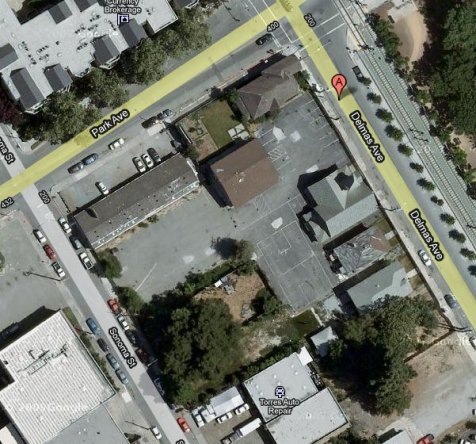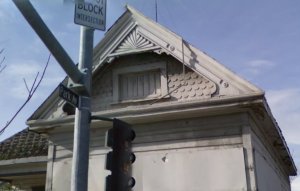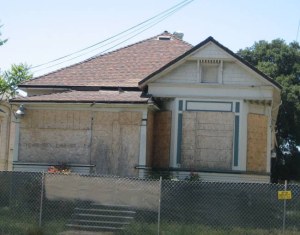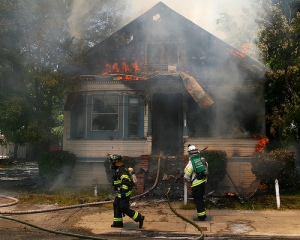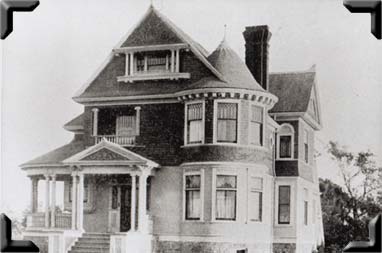The block you see below is now almost completely vacant. Courtesy of Google maps, we can see all of the structures that used to exist, dating all the way back to 1898. These were once grand Victorian homes, full of real people with real stories. Right smack in the middle of it all was a 1903 Colonial Revival Church. Now, thanks to our unenforced vacant building ordinances, they are gone.
This is the current situation in San Jose, California. If you are a vacant historic building, your days are numbered. Just since moving to my neighborhood in February, 2010, I have witnessed 2 suspicious fires to vacant buildings, one of which was slated for inclusion in the National Register, 3 needless teardowns of Victorians, and plenty of other troubling activities.

Delmas Church, Before. This was a Colonial Revival Church built by then pastor Reverend Emil Meyer in 1903, as First German Evangelical Lutheran Church
A suspicious fire on March 23, 2010 consumed the 1903 church on Delmas Avenue. After the discovery of asbestos, the fire investigation was delayed. There has been no news about the cause since.
The church was to be saved and restored, and put on the National Historic Register. The fire changed all that. Sadly, after the church burned, all of the surrounding vacant Victorians were unceremoniously torn down, one after the other. They had been slated for demolition by the owner of the parcel, Mark Robson and Delmas Park LLC.
The Unfortunate Victims
There will never be another 1898 Queen Anne Victorian at the corner of Delmas and Park Avenues. [See below].
German immigrant Louis Bauer acquired the lot at the corner of Delmas and Park Avenue (201-203 Delmas) in 1898 and built his Queen Anne style home. He added a store several years later.
Bauer was a well-known and respected community member who owned a popular saloon on the Alameda among other investments. Before living in this neighborhood myself, I had watched his poor home languish for 10 years on the corner.
Widow Mary Kerr bought the 253 Delmas lot in 1901. She hired architect William Klinkert and contractor D. A. Charteier to design and build her six-room, $1200 home.
A newspaper article featured her home as an example of the pretty homes being built in the district.
John Peschal bought the 255 Delmas lot in 1904. His contractor was the firm of Baron and Woehl. Peschal was a clerk for the popular downtown saloon, “The Tower”. Although all of these buildings could have been moved and salvaged, they were not.
A few blocks away, River Street is being revitalized. Little Italy San Jose could have used some nice Victorians for filling in blank spots. Check them out on Facebook at Little Italy San Jose.
The latest victim?
Only a few blocks away, JNSJ Roofing Co . was the former tenant of this cute little 1915 Victorian at 691 San Carlos Street, San Jose. Take a good look, because it is no more.
. was the former tenant of this cute little 1915 Victorian at 691 San Carlos Street, San Jose. Take a good look, because it is no more.
A four-alarm fire burned the two-story building on Sunday afternoon, June 13th. The blaze was reported at 12:30 p.m. at 691 San Carlos Street. Firefighters declared the flames under control by about 2:40 p.m.
I wish I could end this post on a positive note, but I can’t. If you have vacant historic buildings in your neighborhood, and you don’t want to see “demolition by neglect”, contact your city councilmember.
Let them know you support new laws to keep abandoned buildings secure and protected from fires.
UPDATE: 1/1/2011: The little Victorian at 691 San Sarlos is being rebuilt, and I’m happy to report it looks as though they are restoring it, with historic character intact!
More recent “suspicious” fires…….
Houghton Donner House
The Mansion burned down July 19th, 2007 under “suspicious” circumstances. Preservation Action Council of San Jose had repeatedly made the City aware that it was being broken into and used by vagrants.
It was owned Barry Swenson Builders who had proposed building a 200+ unit residential tower on the site. A nonprofit housing organization was working to relocate and rehabilitate the house and use it for offices. We blogged about this here.
It is worthy of note that on April 26th, 2010 the following memo was presented to the Mayor. “Approval of an ordinance amending Chapter 17.38 – Neglected Vacant Houses Ordinance”
Read the details here:
http://www.sanjoseca.gov/clerk/Agenda/20100511/20100511_0401.pdf
Apparently this ordinance didn’t do a thing to stop the destruction of all the above mentioned historic structures.
